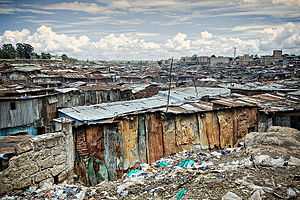Mathare

Mathare is a collection of slums in Nairobi, Kenya with a population of approximately 500,000 people;[1] the population of Mathare Valley alone, the oldest of the slums that make up Mathare, is 180,000 people.[2] Mathare is the home of football team Mathare United of the MYSA.[3]
Gang violence
In 2006, Mathare was damaged by violence between rival gangs the Taliban (not to be confused with the Islamist group of the same name), a Luo group, and the Mungiki, a Kikuyu group.[1] Brewers of an illegal alcoholic drink, chang'aa, asked the Taliban for help after the Mungiki tried to raise their taxes on the drink; since then, fighting between the two has led to the burning of hundreds of homes and at least 10 deaths.[1] Police entered the slum on November 7, 2006, and the General service unit(They are the paramilitary) arrived a day later, but many residents who fled are still afraid to return.[1]
On June 5, 2007, the Mungiki murdered two police officers in Mathare; the same night, police retaliated by killing 22 people and detaining around 100.[4]
Following the controversial presidential elections that took place on December 27, 2007, gangs of Kikuyu and Luo youth engaged in violent fights and burned more than 100 homes.[5]
References
- ↑ 1.0 1.1 1.2 1.3 Gettleman, Jeffrey (2006-11-10). "Chased by Gang Violence, Residents Flee Kenyan Slum". The New York Times (The New York Times Company).
- ↑ "Mathare Valley, Nairobi". ghettoradio.omroep.nl. Ghetto Radio. Retrieved 2006-11-11.
- ↑ "Mathare United". Mathare United Football Club. Retrieved 2006-11-11.
- ↑ "Police in Kenya Kill 22 in Gun Battles Over Sect". The New York Times (Associated Press, republished by The New York Times Company). 2007-06-07.
- ↑ Jeffrey Gettleman, "Disputed Vote Plunges Kenya Into Bloodshed", The New York Times, December 31, 2007.
Further reading
- Rodriguez-Torres, Deyssi. "Public authorities and urban upgrading policies in Eastlands: the example of 'Mathare 4A Slum Upgrading Project." In: Charton-Bigot, Hélène and Deyssi Rodriguez-Torres (editors). Nairobi Today: The Paradox of a Fragmented City. African Books Collective, 2010. p. 61-96. ISBN 9987080936, 9789987080939. The source edition is an English translation, published by Mkuki na Nyota Publishers Ltd. of Dar es Salaam, Tanzania in association with the French Institute for Research in Africa (IFRA) The book was originally published in French as Nairobi contemporain: Les paradoxes d'une ville fragmentée, Karthala Editions (Hommes et sociétés, ISSN 0993-4294). French version article: "Les pouvoirs publics et les politiques de reenovation urbaine aa Eastlands L'exemple du « Mathare 4A Slum Upgrading Project »", p. 101-146.
- De Lame, Danielle. "Grey Nairobi: Sketches of Urban Socialities." In: Charton-Bigot, Hélène and Deyssi Rodriguez-Torres (editors). Nairobi Today: The Paradox of a Fragmented City. African Books Collective, 2010. p. 167-214. French version article: "Gris Nairobi: Esquisses de sociabilités urbaines." p. 221-284. ISBN 2845867875, 9782845867871.
- Includes a section on Mathare, titled "??", p. ??? (In French: "Mathare: vallée de sang et de larmes", p. 272-277).
- "Mathare Valley. A Case Study of Uncontrolled Settlement in Nairobi." University of Nairobi, Housing Research and Development Unit. GITEC Consult (1995).
- "Mathare 4A Development Programme Feasibility Study Report." Ministry?
- Reback, Andrew. "Slum Upgrading Case Study: Nairobi’s Mathare 4A." September 2007.
External links
- Mathare Light Centre Mathare Light Centre is a nonsectarian human development organization. The main goal is to feed and educate children in Mathare.
- Mathare Roots Mathare Roots is a community based organization established in 2006 by local youth ready to make a positive change.
- Rebel film board Rebel film board is our non-profit organization, providing the way for youth in mathare slum to share their stories with the world through video and films.
- OneLife Africa-This organization exists to identify and equip at-risk young people in Mathare slums
- Mathare Valley Outreach
- Mathare Youth Sports Association
- Nairobi Slums School Projects Trust
- The Mwelu Foundation - Grass-roots youth project centering on photography
- Mathare leader working on establishing further social changes in Mathare
- Mercy Care Centre
- Made in the Streets
- Mathare-Inn Photobook Fundraising project by photographer Claudio Allia with texts by Claudio Torres.
| ||||||||||
Coordinates: 1°15′36″S 36°51′43″E / 1.26000°S 36.86194°E
